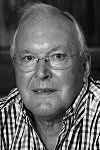 |
| |
Production designer Peter Lamont talks about his
work on the Casino Royale sets and locations, and
his previous 17 Bond films...
|
|
Casino Royale Production Designer Interview
- Peter Lamont
23rd November 2006
Production designer Peter Lamont is steeped in Bond history
stretching back more than four decades. He first film was Goldfinger back in 1964 and Casino
Royale marks his 18th James Bond movie - an
incredible record.
“It’s been fantastic,” says Lamont. “And
obviously working on Bond has been a big part of my life. I’ve
worked on 18 of the 21 films and I’ve enjoyed working on
them enormously. They are great fun and it’s like a huge
family.”
Lamont has only missed three Bond films in total - the
first two, Dr. No and From
Russia With Love were made before
he joined the team and he was absent from Tomorrow
Never Dies because he was already committed to another film.
“Yes, I was on the sinking ship at that time,” he
jokes, referring to Titanic, one of the most successful films
of all time which won him an Oscar for Best Art Direction. Lamont
has also been nominated for an Academy Award on three other occasions,
including for The Spy Who Loved
Me in 1977.
The 77 year old has a wealth of experience and a font
of anecdotes from Bond films which includes working closely
with every actor who has played 007 from Sean
Connery to the latest, Daniel
Craig.
“I think Daniel is a great choice,” he says. “We
were all there when he did the tests and he was the one
who got our vote. He was by far the best.
He moves well,
he’s a great actor, he’s a very handsome fella
and he’s very physical. All great attributes for
James Bond. We were all delighted when he got to have a
crack at it.” |
|
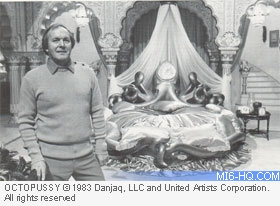
Above: Peter Lamont pictured with the bed he designed for
Octopussy in 1983 |
Lamont began his career as a draughtsman in the 1950s working
in the art department for British films including The Importance
of Being Earnest, A Day To Remember and Miracle In Soho.
He was recruited to the Bond fold by then production designer
Ken Adam and given the kind of challenge that he clearly relishes - to
design the exterior of Fort Knox which would then be built on
the back lot at Pinewood Studios.
Lamont recalls that his designs were poured over by director
Guy Hamilton and the late, legendary Bond producers Cubby Broccoli
and Harry Saltzman, and he feared that he would be ticked off
for his over-lavish and clearly expensive plans.

Above: The protagonists of Goldfinger
(1964) prepare the nuclear device on the Fort Knox set built
on the Pinewood
back lot |
|
I almost fell through the roof because the estimate
was for £56,000 which was the most expensive set
that had ever been built at that time. I thought ‘oh
God, I’m going to get fired for this..’
“But nobody turned a hair. Guy said ‘well,
well eliminate this bit and that bit, and we’ll do
this and this…’ and it came down to about £40,000
and then it was ‘right, build it!’ And we landscaped
the place and built a concrete road into Black Park on
the back lot at Pinewood. It was amazing.”
Some of the challenges on Casino Royale included finding
the right buildings for Hotel Splendide and the casino
itself which Lamont eventually found in the historic spa
town of Karlovy Vary in the Czech Republic." |
A rather dilapidated building called Lazne I was given a make
over by Lamont and the team before filming could begin. But in
the end, it proved the perfect location.
“Unfortunately Lazne was in a bit of a sorry state but
with a bit of tender love and care and the help of the local
preservation group, and our money, I think we put it back to
rights. It did look gorgeous when we finished with it.”
How many Bond films have you done?
Eighteen of the 21. Not all as production designer, I started
as production designer on For Your
Eyes Only and I missed Tomorrow Never Dies because I was on
the sinking ship at that time (Titanic). I started off with Ken
Adam (production designer) as one of his draughtsmen on Goldfinger
so I missed the first two and I missed Tomorrow Never Dies.
What was Sean Connery like to work with?
Oh great, an absolute professional. And Roger
(Moore) was a lovely fella, he was always so well turned
out and knew his lines. He knew everybody and liked a laugh
and a joke with everyone. A Lovely man.
And now you’ve got a new Bond with Daniel Craig..
I think Daniel is a great choice. We were all there
when he did the tests and he was the one who got our vote.
He was by far the best. He moves well, he’s a great
actor, he’s a very handsome fella and he’s
very physical. All great attributes for James Bond. We
were all delighted when he got to have a crack at it.
Do you think that Daniel is closer to Fleming’s
original vision of Bond?
I’m not sure about that. I think Terence Young
(director Dr No and Thunderball)
kind of put everything on the map with how he saw Bond - how
he was dressed, brief case, all of that - and it
all emanated from that. And I think if you look back at
those early Bonds, he is a bit of a snob really - you
know, the cars he drives, the cigarettes he smokes, hand
made shirts. And I think that was how Terence saw it. But
it’s come on since then and we’re now in the
real world. But Terence definitely set a template with
Dr No. |
|

Above: Daniel Craig is the sixth 007 |
How does the whole process of making a Bond movie start for
you?
Well, with Casino Royale, we had done quite a lot of research,
tramping around, trying to decide where we were physically going
to do the film before Martin (Campbell, director) joined and
I must say that once Martin joined as the director it was great
because having worked with him on GoldenEye,
we all knew what a good choice that was. He had put the Bonds
back on the map
again (with GoldenEye) and we had gone from strength to strength
from there.
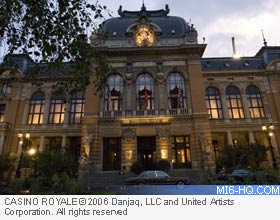
Above: The Hotel Spendide in Casino
Royale |
|
What is the approach with the look of this film?
Well, in many ways we are trying to keep it as close
to the book as we can. And then it’s trying to decide where
you actually see Hotel Splendide and Casino Royale. In Fleming’s
book they are in the South of France. And you start to think
about various places for them and we roamed about all over
the place looking - we went to Croatia, Italy, Spain.
But when we went to Prague it was my suggestion that we should
look outside the city itself to Karlovy Vary because I felt
that had more to offer and hadn’t been seen or over exposed
like Prague itself. It’s a gorgeous looking place,
a great spa town. You have the Grand Hotel Pupp there, the
old
spa building called Lazne I, which became the Casino Royale. |
The geography matched beautifully. Unfortunately Lazne was in
a bit of a sorry state but with a bit of tender love and care
and the help of the local preservation group, and our money,
I think we put it back to rights. It did look gorgeous when we
finished with it. Lazne I was an old spa and all the rooms were
still there but it wasn’t really being used. But it is
a very handsome building.
What about The Bahamas?
Well, we wanted a romantic Caribbean
look. And I’d
been out to The Bahamas several times and thought that if we
were going that way we should think about Nassau. It’s
the convenience of getting there and the closeness to America
that is the charm.
And I presume you’ve been there on previous
Bond films?
Actually we were invited out to Paradise Island and we
did use Paradise Island in Thunderball but it has changed somewhat
since then. When we did Thunderball the beach was open and
the golf course was there but not used, it was just the greens
maintained and that was about it. Going back was somewhat different
because it’s far more populated. And I didn’t realise
what a big island it was because we only used a small part
of it that first time. And actually, we first went out there
on a scouting mission and picked out a location we wanted to
use as a shanty town. And by the time we went back with Martin
it had been renovated! (laughs). So that threw us.
|
|
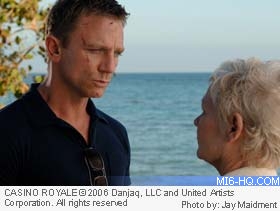
Above: Daniel Craig (007) and Dame
Judi Dench (M) discuss the forthcoming mission on location
in the Bahamas. |
What did you do?
We took Martin to a place we used to dine
at when we were doing The Spy Who Loved Me which is now derelict
and that became
the base for our shanty town. We had a look at Coral Harbour
which was another place we’d used on Thunderball and there’s
a building that was meant to be an hotel that was never finished
because of some dispute or another. And Martin thought that was
wonderful, so we used that as well.
And what sets did you build on the 007 stage at Pinewood?
Well, we built the interior of the sinking house here. The sinking house features in one of the big scenes in the film and is meant to be in Venice. We did a model of the sinking house so that it could be deposited into the real Grand Canal. And we did a guerrilla camp that is supposed to be in Uganda in Black Park (on the Pinewood back lot). And we used one of the cricket pavilions at Eton College for a cricket match.
Cast your mind back to that first Bond. What were your expectations? I mean, presumably you weren’t thinking ‘I’ll be doing these films for the next forty years…’
No. I just went on as a draughtsman and met Ken Adam and he gave a great folder and it was the exterior of Fort Knox and he said ‘have a go at that..’ And I remember he would pop in daily and have a look over my shoulder to see what I was doing and during that month I drew it all up and made a model. And I remember Guy Hamilton (director), Cubby (Broccoli, producer)
and Harry (Saltzman, producer) came up and they looked at it
and said ‘well, let’s get an estimate of how much it’s going to cost..’ And I almost fell through the roof because the estimate was for £56,000 which was the most expensive set that had ever been built at that time. I thought ‘oh God, I’m going to get fired for this..’ But nobody turned a hair. |
|
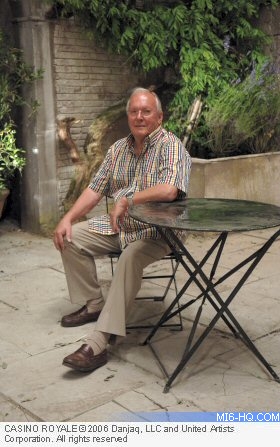
Above: Peter Lamont on the piazza he designed for Casino Royale (built on the 007 stage at Pinewood Studios). |
Guy said ‘well, well eliminate this bit
and that bit, and we’ll do this and this…’ and
it came down to about £40,000 and then it was ‘right,
build it!’ And we landscaped the place and built a concrete
road into Black Park on the back lot at Pinewood. It was amazing.
And we did all that sequence and then when the film was finished
Peter Hunt (editor) went out and took some aerial shots around
the real Fort Knox because they wouldn’t let us shoot there
at all. So we did the exterior and there was that wonderful set
of Ken’s of the interior where Oddjob (Harold Sakata) meets
his fate with Bond.
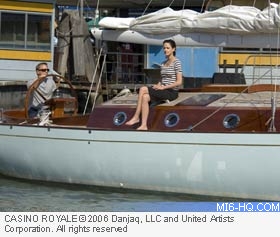
Above: Daniel Craig sails down the
Grand Canal in Venice whilst Eva Green looks on |
|
When you left that film did you hope to work with the
Bond team again?
Well, Harry had me in his office and said ‘have
a holiday because we’ve got a big programme coming up..’ I
remember I worked on The Ipcress File and then Ken buzzed into
the office one day and said ‘children, we’re going
to do Thunderball.’ And then he said ‘somebody
had better learn to swim under water.’ I remember I joined
a sub aqua club in Slough and they did me a crash course so
that when we went out to The Bahamas I would be able to work
on the set underwater. We built the interior of a Vulcan Bomber
that had to be sunk in 60 feet of water, with the atomic weapons
and all of that, that was my job. I went out there for 2 weeks
and stayed 14. |
You’ve certainly had a remarkable career..
Well, I’ve
done all the jobs and I can make tea quite well. (laughs)
You’ve done many other movies but Bond has punctuated
your career hasn’t it?
Yes it has. It’s been a long time and it’s been
wonderful. I went off and did other things. It worked out that
when we had the 40th anniversary on the last picture we’d
done 20 pictures in 40 years which is, of course, one every two
years. I would do a picture, go away and do something else and
come back again. It was just by sheer luck I suppose. And I’ve
enjoyed working on them enormously. They are great fun and it’s
like a huge family. Cubby’s edict always was ‘if
you’ve got something to say, say it..’ because it
might be rubbish or it might be the start of something wonderful,
but for God’s sake, say it.
What was Cubby like?
A lovely person and he always thought
of the crew. He always used to meet everyone in the bar when
we went anywhere and buy
us all a drink. He was wonderful. The whole family are lovely.
What has made the films so successful?
I think it’s being there at the right time and very
high production values. We try to do things in the best way.
Even now, we try not to get into too many gimmicks, we try and
do things the real way. When you see the chase in Casino Royale
it’s quite amazing what we’ve done and it’s
for real.
Will you do the next Bond?
Yes, hopefully I will.
How old are you, may I ask?
I’ll be 77 this year. And
I enjoy it as much now as I did in the beginning.
What do you enjoy the most?
Well, as I say, they are nice people
to work with and we do get a free hand. And there’s a great feeling that we
are all on the same team trying to do the very, very best. My
edict is that when I do second best I’ll give up.
Produced by Michael G. Wilson and Barbara
Broccoli (Eon Productions) and directed by Martin Campbell,
CASINO ROYALE was released on November 16, 2006
in the UK. Principal photography started on
January 30th 2006, with locations in the UK, Czech Republic
(Prague), Italy, and the Bahamas. It is British actor
Daniel Craig’s first outing as James Bond. He is the
sixth actor to play the 007 role in the franchise.
The film also stars Judi Dench, Eva Green, Mads
Mikkelsen, Jeffrey Wright, Giancarlo Giannini, Caterina Murino,
Simon Abkarian, Tobias Menzies, Ivana Milicevic, Clemens Schik,
Ludger Pistor, Claudio Santamaria and Isaach de Bankole.
Related Articles
 Casino
Royale Coverage
Casino
Royale Coverage
Thanks to Sony Pictures Entertainment